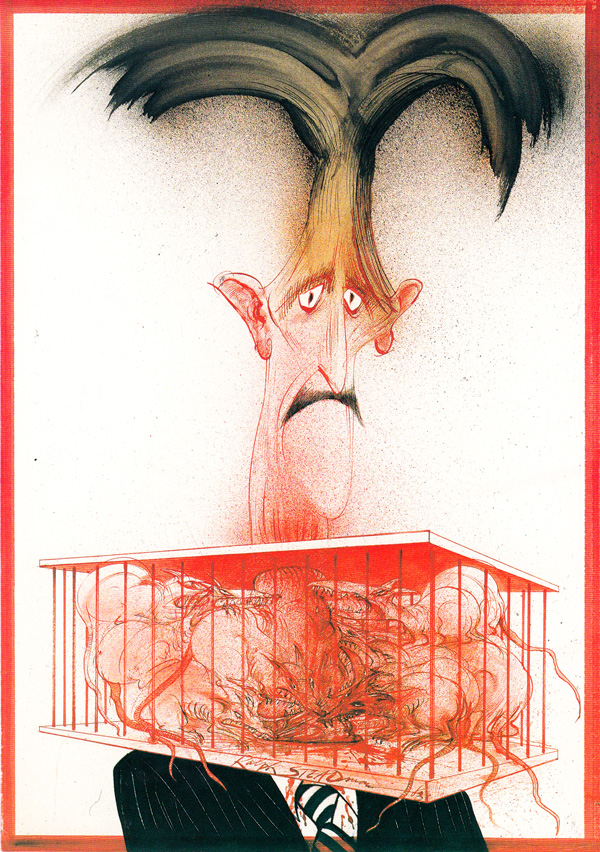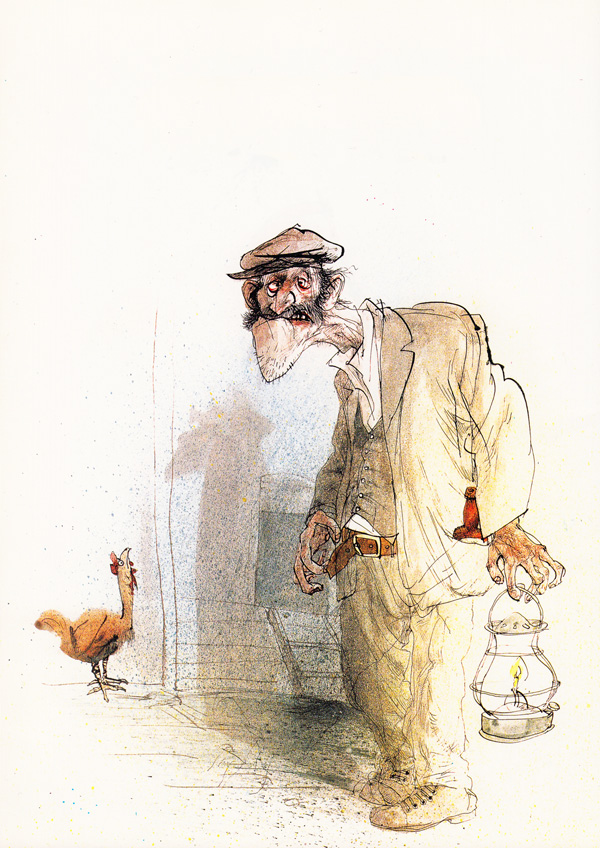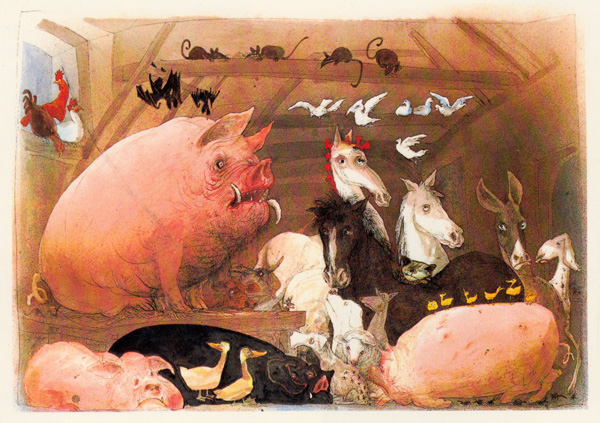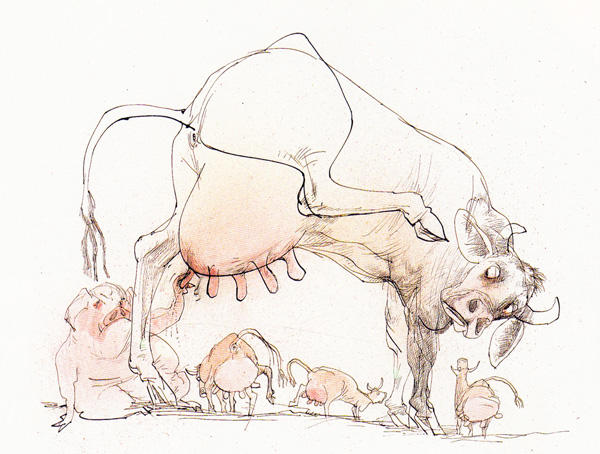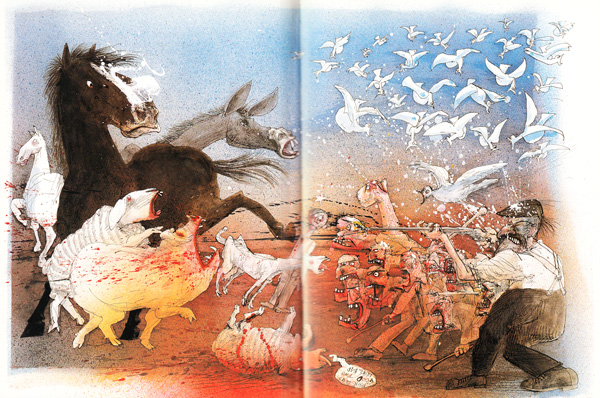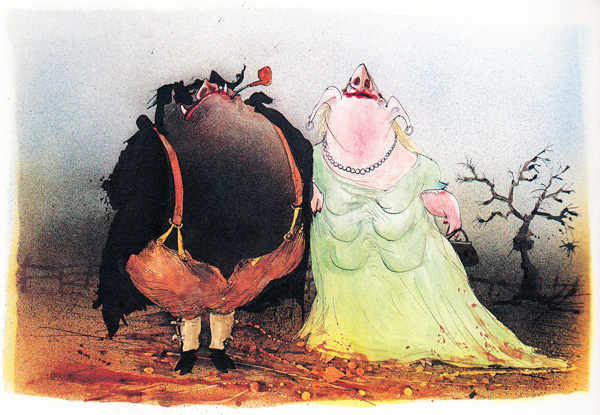It is now 65 years since George Orwell died, and he has never been bigger. His phrases are on our lips, his ideas are in our heads, his warnings have come true. How did this happen?
我生平第一本英文小說,George Orwell 的 Animal Farm (1945)。那時 (1968),似乎有梁實秋先生的翻譯本《百獸圖》,不過,省立台中圖書館有原文書,就"不知不覺"讀完它。當時,我不會在意翻譯本之比較,而是「得魚忘筌」。
幾十年之後,我的朋友Peter去讀學士後法律課程,課程中,老師要大家討論書中的聰明豬與百獸的約定,算的上農場的「憲法」嗎?
2011年讀George Orwell 書信,他希望將此處改一處,為”眾牲都大驚失色,惟拿破侖處之泰然…….”…..因為史達林 (J.S.) 當時沒離開莫斯科…….
2014.9.24
今日是香港學生舉行為期一周的罷課活動的第二天,學生們坐在香港政府附近的區域聆聽有關民主和公民社會的演講。
在香港嶺南大學教授歷史的David Lloyd Smith做了有關喬治•奧威爾(George Orwell)的演講并將香港的民主發展比作朝鮮,朝鮮有正式的普選,但只有經過政府審查的人才能參選。
現年21歲、就讀香港科技大學(Hong Kong University of Science and Technology)商業專業的學生Christine Tong說,有關喬治•奧威爾的演講引起了她的共鳴。她說,香港政府就好比《動物莊園》(Animal Farm)裡的豬,利用自己的權力來壓制其他動物,違背自己的原則。
另一場關於莫罕達斯•甘地(Mohandas Gandhi)和公民抗命的演講也吸引了學生以及其他一些佩戴黃絲帶、支持“佔中”運動的人。
Animal Farm was the first animated film made by the British film industry in 1954. But what nobody realised at the time, least of all the producers, was that the film was financed by the CIA as part of the Cold War effort...
Listen to The Film Programme: http://bbc.in/1wOW7MU
Listen to The Film Programme: http://bbc.in/1wOW7MU
1945
When Animal Farm was published in 1945, its British author George Orwell (a pseudonym for Eric Arthur Blair) had already waited a year and a half to see his manuscript in print. Because the book criticized the Soviet Union, one of England's allies in World War II, publication was delayed until the war ended. It was an immediate success as the first edition sold out in a month, nine foreign editions had appeared by the next year, and the American Book-of-the-Month Club edition sold more than a half-million copies. Although Orwell was an experienced columnist and essayist as well as the author of nine published books, nothing could have prepared him for the success of this short novel, so brief he had considered self-publishing it as a pamphlet. The novel brought together important themes — politics, truth, and class conflict — that had concerned Orwell for much of his life. Using allegory — the weapon used by political satirists of the past, including Voltaire and Swift — Orwell made his political statement in a twentieth-century fable that could be read as an entertaining story about animals or, on a deeper level, a savage attack on the misuse of political power. While Orwell wrote Animal Farm as a pointed criticism of Stalinist Russia, reviews of the book on the fiftieth-anniversary of its publication declared its message to be still relevant. In a play on the famous line from the book, "Some animals are more equal than others," an Economist reviewer wrote, "Some classics are more equal than others," and as proof he noted that Animal Farm has never been out of
print since it was first published and continues to sell well year after year.
George Orwell’s Animal FarmIllustrated by Ralph Steadman
by Maria Popova“I do not wish to comment on the work; if it does not speak for itself, it is a failure.”
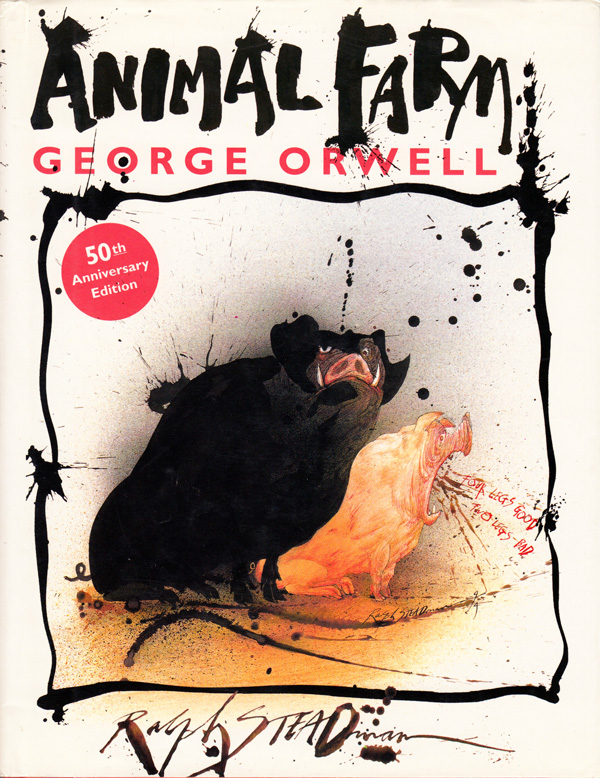 In 1995, more than twenty years after hisirreverent illustrations for Alice in Wonderland, the beloved British cartoonistRalph Steadman put his singular twist on a very different kind of literary beast, one of the most controversial books ever published. To commemorate the 50th anniversary of the first American publication of George Orwell’s masterpiece, which by that point had sold millions of copies around the world in more than seventy languages, Steadman illustrated a special edition titled Animal Farm: A Fairy Story (public library), featuring 100 of his unmistakable full-color and halftone illustrations.
In 1995, more than twenty years after hisirreverent illustrations for Alice in Wonderland, the beloved British cartoonistRalph Steadman put his singular twist on a very different kind of literary beast, one of the most controversial books ever published. To commemorate the 50th anniversary of the first American publication of George Orwell’s masterpiece, which by that point had sold millions of copies around the world in more than seventy languages, Steadman illustrated a special edition titled Animal Farm: A Fairy Story (public library), featuring 100 of his unmistakable full-color and halftone illustrations.Accompanying Steadman’s illustrations is Orwell’s proposed but unpublished preface to the original edition, titled “The Freedom of the Press” — a critique of how the media’s fear of public opinion ends up drowning out the central responsibility of journalism. Though aimed at European publishers’ self-censorship regarding Animal Farm at the time, Orwell’s words ring with astounding prescience and timeliness in our present era of people-pleasing “content” that passes for journalism:
The chief danger to freedom of thought and speech at this moment is not the direct interference of … any official body. If publishers and editors exert themselves to keep certain topics out of print, it is not because they are frightened of prosecution but because they are frightened of public opinion. In this country intellectual cowardice is the worst enemy a writer or journalist has to face.
Alas, this exquisite edition is no longer in print, but I was able to track down a surviving copy and offer a taste of Steadman’s genius for our shared delight.
Also included is Orwell’s preface to the 1947 Ukrainian edition, equally timely today for obvious geopolitical reasons. In it, he writes:
I understood, more clearly than ever, the negative influence of the Soviet myth upon the western Socialist movement.And here I must pause to describe my attitude to the Soviet régime.I have never visited Russia and my knowledge of it consists only of what can be learned by reading books and newspapers. Even if I had the power, I would not wish to interfere in Soviet domestic affairs: I would not condemn Stalin and his associates merely for their barbaric and undemocratic methods. It is quite possible that, even with the best intentions, they could not have acted otherwise under the conditions prevailing there.But on the other hand it was of the utmost importance to me that people in Western Europe should see the Soviet régime for what it really was…I have been convinced that the destruction of the Soviet myth was essential if we wanted a revival of the Socialist movement.
Orwell concludes with a note on his often misconstrued intent with the book’s ultimate message:
I do not wish to comment on the work; if it does not speak for itself, it is a failure. But I should like to emphasize two points: first, that although the various episodes are taken from the actual history of the Russian Revolution, they are dealt with schematically and their chronological order is changed; this was necessary for the symmetry of the story. The second point has been missed by most critics, possibly because I did not emphasize it sufficiently. A number of readers may finish the book with the impression that it ends in the complete reconciliation of the pigs and the humans. That was not my intention; on the contrary I meant it to end on a loud note of discord, for I wrote it immediately after the Teheran Conference which everybody thought had established the best possible relations between the USSR and the West. I personally did not believe that such good relations would last long; and, as events have shown, I wasn’t far wrong.
Steadman’s Animal Farm: A Fairy Story is spectacular in its entirety, should you be so fortunate to snag a used copy. Complement it with his illustrated edition of Alice in Wonderland and his inkblot dog drawings, then be sure to take a closer look at Orwell’s “The Freedom of the Press.”
Donating = Loving
Bringing you (ad-free) Brain Pickings takes hundreds of hours each month. If you find any joy and stimulation here, please consider becoming a Supporting Member with a recurring monthly donation of your choosing, between a cup of tea and a good dinner.


